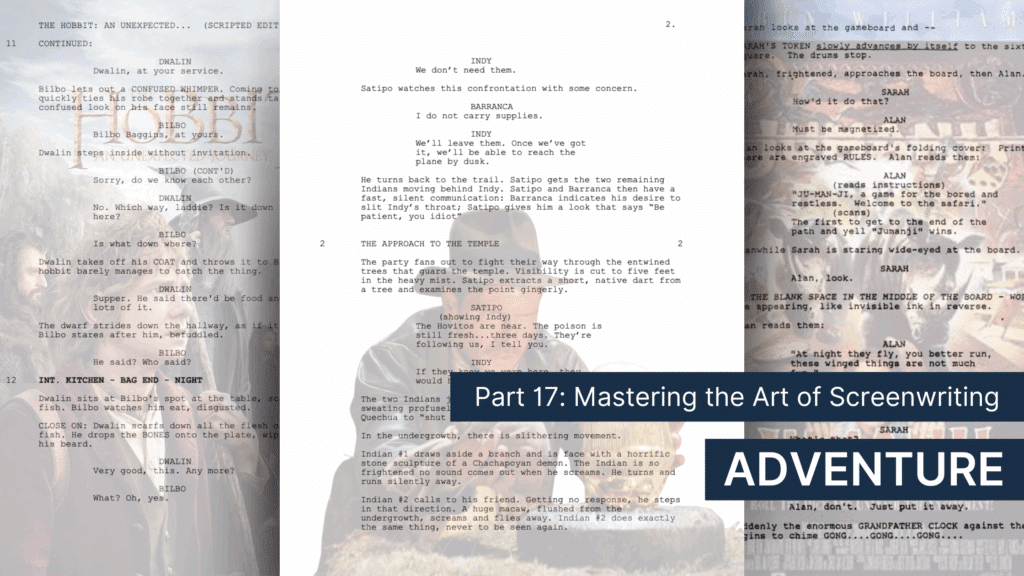
Welcome back to our Mastering the Art of Screenwriting series! We’re so glad you’re here. Today, we’ve a quest…
Adventure stories are timeless and have had us on the edge of our seats for generations. From ancient myths passed down around blazing campfires to modern cinematic blockbusters, audiences have always been captivated by strange lands and daunting challenges, leaving their jaws on the floor as they leave the movie theatre.
But writing an adventure script is more than just plotting an exciting string of events; it’s about crafting a journey where both the characters and audience grow.
Whether your story spans continents, galaxies, or even just one magical street, the core of the adventure is the transformation that happens along the way.
Okay, but how do you actually put pen to paper (or in our case, fingertip to keyboard) and create an epic adventure story that’ll keep your audience captivated? Well, join us on an adventure of our very own as we explore the structure, characters, world building, and tools you can use to bring your screenplay to life.
Along the way, you’ll discover some of our top tips to help you in your adventure writing journey.
Got your adventuring supplies? Then, it’s time to begin…
Table of Contents
- What is an Adventure Script?
- Key Elements of Adventure Stories
- Adventure vs. Action: What’s the Difference?
- Structuring an Adventure Script
- Building Your Adventure World
- Creating Dynamic Adventure Characters
- Examples of Great Adventure Scripts
- Common Tropes (and How to Use or Subvert Them)
- Tools to Help You Write Your Adventure Script
- Final Tips Before You Begin Your Quest
- Conclusion
What Is an Adventure Script?
An adventure script is a blueprint for a story that takes its characters (and audience) beyond the boundaries of the familiar, through a series of challenges, toward a meaningful goal.
Sounds very much like an action script, right? Well, there are some big differences between action and adventure.
While action films tend to prioritize speed, spectacle, and combat, adventure focuses on the journey and emotional stakes. That’s not to say that adventure can’t have thrilling moments (it absolutely can!), but its heart lies in exploration and transformation.
In short, an adventure script is a journey with stakes, a test of character where the external obstacles force internal growth, and an experience of discovery where the characters learn something new about the world, about others, or even themselves.
Think The Secret Life of Walter Mitty. Yes, there are moments of danger throughout the movie, but the focus isn’t on explosive combat. Instead, it’s all about Walter stepping outside his comfort zone and becoming the hero of his own life.
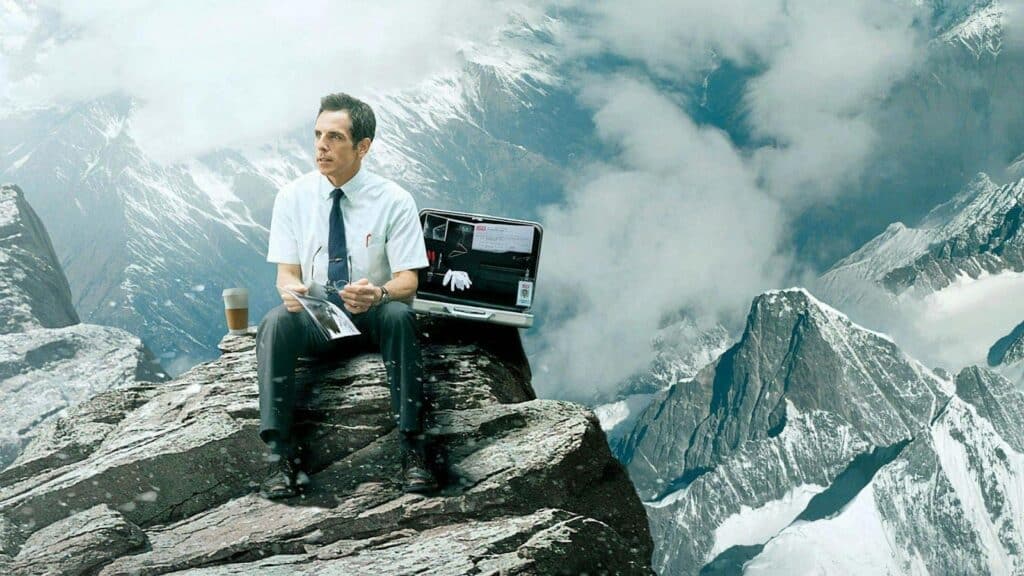
Key Elements of Adventure Stories
Like all other stories, if you want to write a good one (you do, don’t you?), it needs to resonate with your intended audience. In order for your story to do that, you might want to consider including these key elements:
Protagonist with a Clear Goal
Your hero needs something to strive toward, whether that be a quest, mission or a mystery to solve. Without a goal, the journey quickly loses its momentum. This goal should be clear but allow for surprises along the way.
A World Unknown
Adventure thrives in the unfamiliar. This doesn’t necessarily mean it needs to take place within a fantasy world. It’s all about the protagonist stepping into a realm they don’t fully understand, like Into the Wild or 127 Hours.
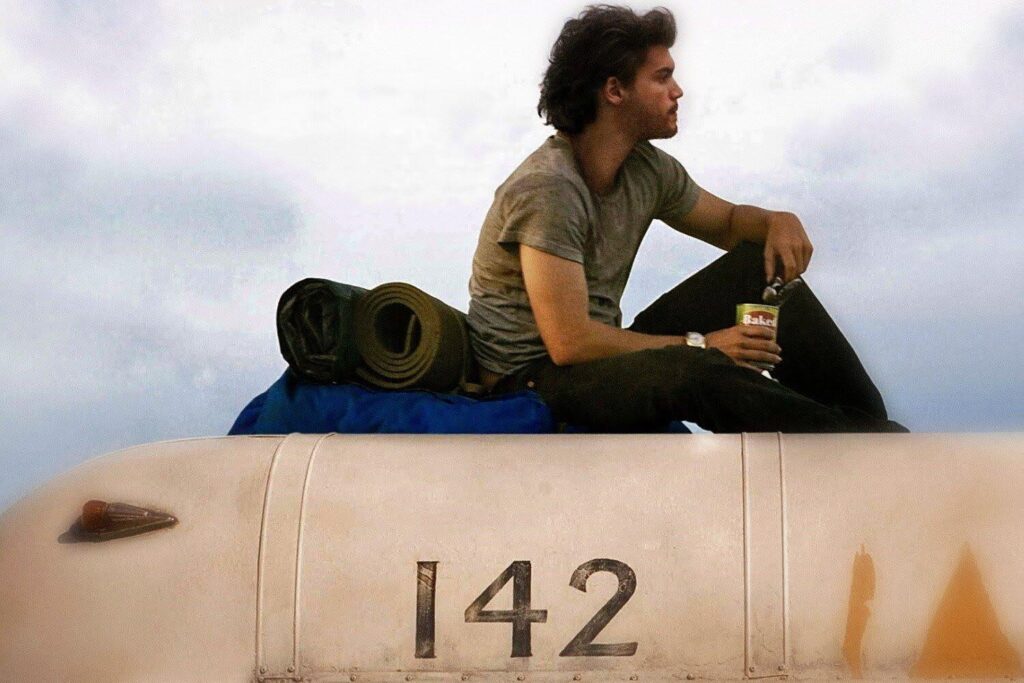
High Stakes
The stakes you put into your adventure story can be emotional, relational or even existential. The fear of losing a loved one, missing a once-in-a-lifetime opportunity, or failing to live up to one’s own ideals can be as gripping as any deadly trap.
Companions or a Team
Few great adventures are undertaken alone. Companions bring diversity in skills, perspectives, and emotional beats. A mentor, a skeptic, a comic relief, or even a rival can enrich the journey.
Obstacles and Inner Growth
The external challenges (rivers to cross, codes to crack, enemies to evade) should mirror the protagonist’s internal struggles. Overcoming the outside world helps them overcome their inner flaws.
Adventure vs. Action: What’s the Difference?
We’ve already touched upon the differences between adventure and action stories, but let’s dive a little deeper. While both genres can involve danger, fast pacing, and larger-than-life set pieces, the difference lies in each genre’s focus.
In adventure stories, the emotional transformation is as important as the outcome. As you write, your pacing should breathe to allow for reflection and character beats.
Whereas in action stories, the emphasis is on adrenaline, set pieces, and constant forward motion. Emotional arcs are secondary to spectacle.
Okay, yes you can combine both. Indiana Jones does! Yet while there are heart-stopping moments of action, the stories often pause to allow for quiet human moments. Raiders of the Lost Ark is one example where Indy and Marion share muted time together amidst the chaos.
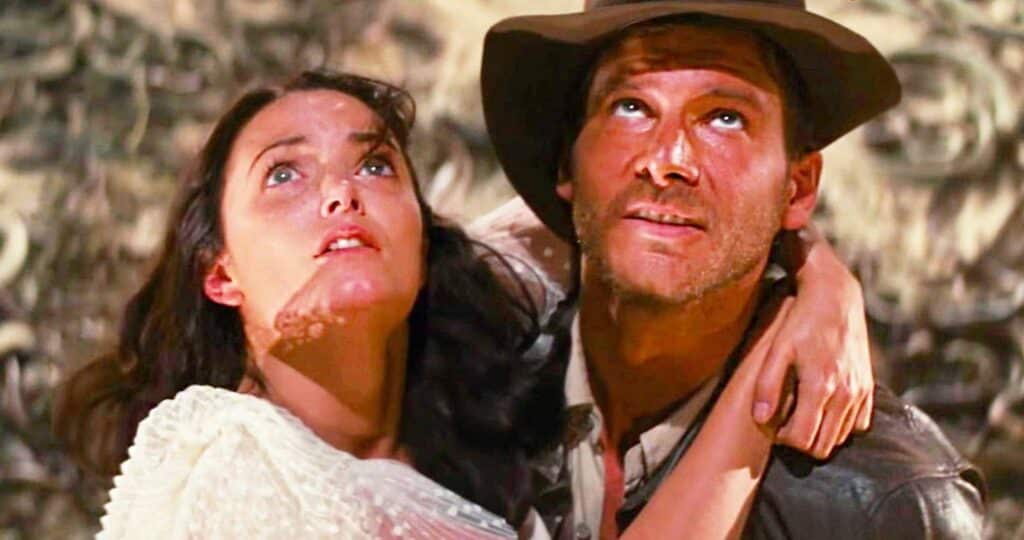
Structuring an Adventure Script
So, with all of the above to take into consideration, it’s time to start planning your script. You’ll find many adventure stories loosely follow the Hero’s Journey, but flexibility is key! Here’s a practical structure you can use to bring your basic plot to life:
1. Setup/Ordinary World
Start by introducing your protagonist’s everyday life. Show their strengths, flaws, and the gap between who they are and who they need to become.
2. Inciting Incident
Next, decide on the event that disrupts their comfort zone, whether it’s an ancient map landing in their hands or a loved one vanishing.
3. Crossing the Threshold
This is the moment they commit to the journey and leave the familiar behind. This should feel like a point of no return.
4. Trials and Allies
Challenges, puzzles, and adversaries appear. The protagonist gains allies, learns new skills, and faces setbacks.
5. The Crisis
A low point where all seems lost. Perhaps the team is scattered, the treasure stolen, or the hero’s faith broken.
6. The Climax
The final confrontation with the ultimate challenge, often requiring the hero to apply both their new skills and personal growth.
7. The Return
This is the journey’s end, with the hero changed. Sometimes they bring back a literal prize, other times it’s wisdom or a renewed purpose.
Building Your Adventure World
Ooo, world building. Now we’re getting to the good stuff. The setting in an adventure setting is more than just the background, but often a character within itself.
Whether you choose for your story to take place in a mythical jungle or a gritty urban sprawl, the environment should shape the challenges, influence character decisions, and reinforce your themes.
Tips for Immersive World Building
- Use sensory details (describe what a character sees, hears, smells, and feels)
- Show cultural depth (invent customs, slang, or rituals to make a world feel more lived-in)
- Integrate history (hint at legends, past conflicts, or forgotten ruins to give the world layers)
With world building, there’s lots to organize. Make sure to use Celtx’s catalog and breakdown tools to log locations, props, and character details to manage everything as you go.
Creating Dynamic Adventure Characters
Adventure characters are an exciting breed and are usually reluctant at the beginning of the story to go out on their quest. Just like Bilbo Baggins who’s someone very ordinary, thrust into the realms of the extraordinary.
And the realms of the extraordinary should alter the protagonist. For example, in The Hobbit, Bilbo Baggins starts as a comfort-loving hobbit who shuns adventure. But by journey’s end, he’s resourceful, brave, and forever changed. His trials turn him from reluctant tag-along into a true hero in his own right.
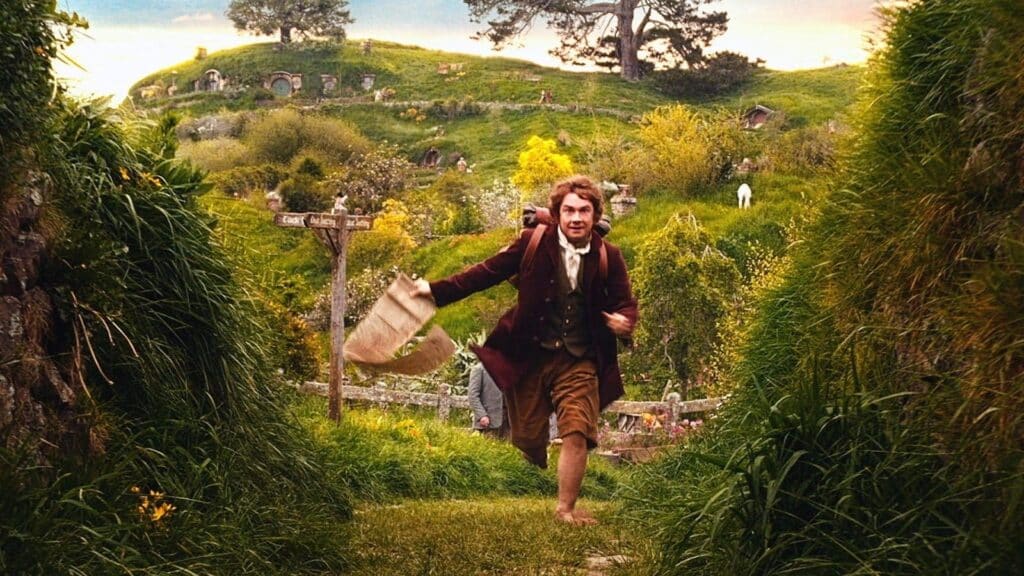
Supporting Cast
And every reluctant hero needs a team! Strong supporting characters can make or break an adventure, no matter how compelling the protagonist.
- The Mentor offers guidance but can withhold key truths
- The Comic Relief eases tension without completely derailing
- The Betrayer is the wildcard character who raises the stakes
- The Challenger forces the hero to think differently
“The usual hero adventure begins with someone from whom something has been taken, or who feels there is something lacking in the normal experience available or permitted to the members of society. The person then takes off on a series of adventures beyond the ordinary, either to recover what has been lost or to discover some life-giving elixir. It’s usually a cycle, a coming and a returning.” – Joseph Campbell (A Hero with A Thousand Faces)
Examples of Great Adventure Scripts
As we continue our journey through adventure scripts, we discover a well-earned reward: killer examples! Here are our top picks of adventure screenplays you need to check out!
Indiana Jones: Raiders of the Lost Ark (1981)
Written by Lawrence Kasdan, the screenplay strikes a fine balance of action spectacle with mythic stakes and witty character interplay.
The Goonies (1985)
Chris Columbus’ heartfelt, youthful treasure hunt script celebrates friendship and exploration.
Jumanji (1995)
Screenwriter Jonathan Hensleigh crafted a script that beautifully shows how characters adapt to unfamiliar rules and roles.
Life of Pi
This renowned spiritual and survival odyssey written by Yann Martel and David Magee is wrapped in stunning visuals and a compelling bond between man and beast.
Common Tropes (and How to Use or Subvert Them)
You’ll find that adventure stories often draw on familiar building blocks and recurring motifs that are instantly recognizable.
Used thoughtfully, these tropes can enhance your script. Subvert them, and they can surprise and delight your audience.
So, what are the common tropes? And how can you use them effectively in your next adventure script?
The MacGuffin
This is the object that drives the plot, like the ark in Raiders of the Lost Arc, and Paradise Falls in Up.
You can subvert the MacGuffin trope by making the ‘object’ irrelevant by the end, instead focusing on the growth of the characters.
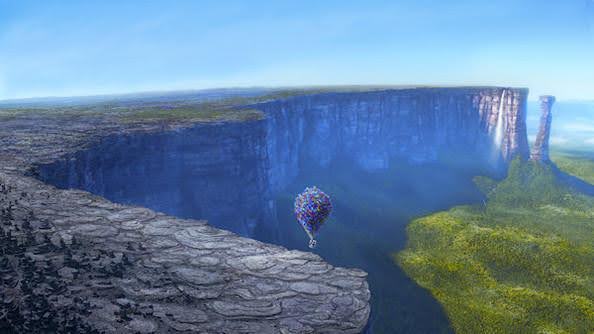
The Map
A literal guide to adventure! You could twist this by having the ‘map’ be a person’s memories or stories.
In The Hobbit, Thorin’s map literally charts the way to the Lonely Mountain, but the true ‘map’ is also the dwarves’ shared history and songs, which guide their purpose.
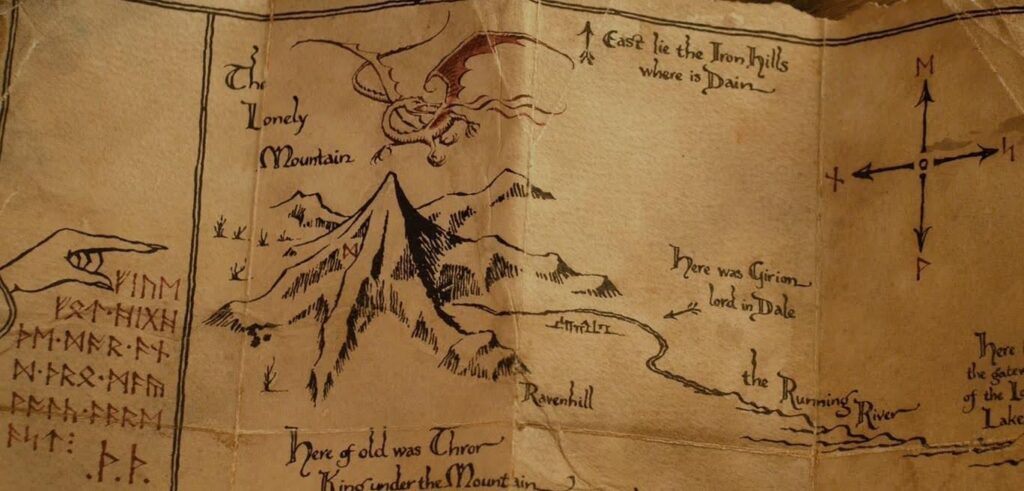
The Rival Explorer
Having another explorer directly parallel to your protagonist can add tension and mirror your hero’s flaws.
Returning to Indiana Jones, in The Last Crusade, Indy’s rival archaeologist, Elsa Schneider mirrors his passion for discovery, but her greed corrupts it, raising personal and moral stakes.

Tools to Help You Write Your Adventure Script
It’s the part of the blog where we shamelessly plug Celtx’s array of production tools! It just so happens that they fit adventure writing perfectly. So, what are they?
- Beat Sheet: Map out key plot points before moving onto your first draft
- Storyboard Tools: Visualize big set pieces and transitions]
- Script Insights: Track pacing, scene density, and dialogue balance
- Character Profiles: Keep each character arc and personality consistent
Final Tips Before You Begin Your Quest
And so, we come to the end of our adventure all about adventures (sounds kinda Inception-y, right?) Before you dive into a quest of your very own, here are our top tips to get you started.
1. Know Your Ending
…before you start! Adventure works best when every step builds towards a meaningful resolution
2. Keep Your Stakes Personal
Even world-saving quests should have an emotional throughline.
3. Use Your Environment
Let the environment around your characters challenge, inspire, and change your characters.
4. Balance Action and Reflection
Without quiet beats, the thrills lose impact, so make sure you consider both as you plan and write.
5. Let Your Characters Surprise You
The very best adventures feel alive because the characters make unexpected choices. Lean into that, and let your characters lead the way.
Conclusion
Adventure scripts invite audiences to step into the unknown and emerge changed. They remind us that the greatest journeys are as much about inner landscapes as distant horizons. By grounding your quest in emotional truth, building immersive worlds, and crafting memorable companions, you’ll create an adventure worth taking.
As you set out to write your own, remember: the real treasure isn’t just the finished script: it’s the process of discovery along the way.
Learn to write a script in any genre with our screenwriting series!
- Horror: From Dreams to Screams
- Horror: How to Write a Horror Script Part 2
- Science Fiction: Beyond the Stars
- Comedy: Timing, Characters, and Chaos
- Drama: Human Stories, High Stakes
- Rom-Com: From Meet-Cutes to Happy Endings
- Holiday: Crafting Seasonal Magic
- Documentary: Research and Reality
- Skit: Writing Punchlines that Land
- Romance: How to Sweep Audiences Off Their Feet
- Mystery: Leaving Breadcrumbs Without Losing the Plot
- Musical: Writing Rhythm & Emotion
- Action: Writing Momentum on the Page
- Fantasy: Legacy and Lore
- Period: Pieces with a Punch – Writing a Historical Script
